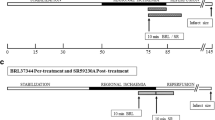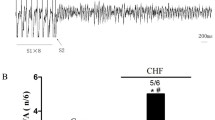Abstract
Endogenous catecholamines released during myocardial ischemia have been considered both to aggravate cell injury and exacerbate arrhythmias and to exert a protective action on the post-ischemic contractile function. The present work was addressed to look for evidence to explain this controversy. The effects of cardiac catecholamine depletion and of α- and β-adrenoceptor (AR) blockade on the post-ischemic contractile dysfunction, as well as its possible relationship with cardiac oxidative stress, were studied in isolated and perfused rat hearts submitted to 20 min of ischemia and 30 min of reperfusion (stunning). Catecholamine depletion improves the contractile recovery in the stunned heart. This mechanical effect was associated with decreased levels of lipid peroxidation. A similar enhancement of the contractile function during reperfusion was detected after the simultaneous blockade of α1- and β-ARs with prazosin plus propranolol. To ascertain which specific AR pathway was involved in the effects of catecholamines on the stunned heart, selective AR blockers, prazosin (α1-blocker), atenolol (β1-blocker), ICI 118,551 (β2-blocker) and selective inhibitors of Gi-PI3K pathway (pertussis toxin and wortmannin) were alternatively combined. The results indicate that catecholamines released during ischemia exert a dual action on the contractile behavior of the stunned heart: a deleterious effect, related to the activation of the β2-AR-Gi-PI3K-pathway, which was counteracted by a beneficial effect, triggered by the stimulation of α1-AR. Neither the depression nor the enhancement of the post-ischemic contractile recovery were related with the increase in ROS formation induced by endogenous catecholamines.






Similar content being viewed by others
References
Amin JK, Xiao L, Pimentel DR, Pagano PJ, Singh K, Sawyer DB, Colucci WS (2001) Reactive oxygen species mediate α-adrenergic receptor-stimulated hypertrophy in adult rat ventricular myocytes. J Mol Cell Cardiol 33:131–139. DOI 10.1006/jmcc.2000.1285
Angelos MG, Murray HN, Waite MD, Gorsline RT (2002) Postischemic inotropic support of the dysfunctional heart. Crit Care Med 30:410–416
Banerjee A, Locke-Winter C, Rogers KB, Mitchell MB, Brew EC, Cairns CB, Bensard DD, Harken AH (1993) Preconditioning against myocardial dysfunction after ischemia and reperfusion by an α1-adrenergic mechanism. Circ Res 73:656–670
Bartels LA, Clifton GD, Szabo TS (1998) Influence of myocardial ischemia and reperfusion on β-adrenoceptor subtype expression. J Cardiovasc Pharmacol 31:484–487
Bers DM (2001) Excitation-contraction coupling and cardiac contractile force, 2nd edn. Kluwer Academic Publishers, The Netherlands, pp 275–282
Bolli R (1990) Mechanism of myocardial “stunning”. Ciculation 82:723–738
Bolli R, Marbán E (1999) Molecular and cellular mechanisms of myocardial stunning. Physiol Rev 79:609–634
Bolli R, Zhu WX, Myers ML, Hartley CJ, Roberts R (1985) Beta-adrenergic stimulation reverses postischemic myocardial dysfunction without producing subsequent functional deterioration. Am J Cardiol 56:964–968
Buege JA, Aust SD (1978) Microsomal lipid peroxidation. Meth Enzymol 52:302–309
Carrozza JP Jr, Bentivegna LA, Williams CP, Kuntz RE, Grossman W, Morgan JP (1992) Decreased myofilament responsiveness in myocardial stunning follows transient calcium overload during ischemia and reperfusion. Circ Res 71:1334–1340
Chiappe de Mon LE, Chiappe de Cingolani GE, Cingolani HE (1978) Effect of acidosis on heart cAMP-dependent protein kinase. Arch Int Physiol Biochim 86:277–287
Daaka Y, Luttrell LM, Lefkowitz RJ (1997) Switching of the coupling of the β2-adrenergic receptor to different G proteins by protein kinase A. Nature 390:88–91
Dart AM, Du XJ (1993) Unexpected drug effects on autonomic function during myocardial ischaemia. Cardiovasc Res 27:906–914
Du XJ, Vincan E, Woodcock DM, Milano CA, Dart AM, Woodcock EA (1996) Response to cardiac sympathetic activation in transgenic mice overexpressing β2-adrenergic receptor. Am J Physiol 271:H630–H636
Egert S, Nguyen N, Schwaiger M (1999) Contribution of α-adrenergic and β-adrenergic stimulation to ischemia-induced glucose transporter (GLUT) 4 and GLUT1 translocation in the isolated perfused rat heart. Circ Res 84:1407–1415
Endoh M (1999) Muscarinic regulation of Ca2+ signaling in mammalian atrial and ventricular myocardium. Eur J Pharmacol 375:177–196
Frances C, Nazeyrollas P, Prevost A, Moreau F, Pisani J, Davani S, Kantelip JP, Millart H (2003) Role of β1- and β2-adrenoceptor subtypes in preconditioning against myocardial dysfunction after ischemia and reperfusion. J Cardiovasc Pharmacol 41:396–405
Grimm M, Kurz T, Schwarz M, Richardt D, Schäfer U, Katus HA, Richardt G (2001) Presynaptic regulation of cardiac norepinephrine release in ischemia. J Cardiovasc Pharmacol 38:58–68
He JQ, Balijepalli RC, Haworth RA, Kamp TJ (2005) Crosstalk of beta-adrenergic receptor subtypes through Gi blunts beta-adrenergic stimulation of L-type Ca2+ channels in canine heart failure. Circ Res 97:566–573. DOI 10.1161/01.RES.0000181160.31851.05
Hearse DJ, Sutherland FJ (1999) Catecholamines and preconditioning: studies of contraction and function in isolated rat hearts. Am J Physiol 277:H136–H143
Huang CH, Vatner SF, Peppas AP, Yang G, Kudej RK (2003) Cardiac nerves affect myocardial stunning through reactive oxygen and nitric oxide mechanisms. Circ Res 93:866–873. DOI 10.1161/01.RES.0000097762.64561.D2
Ishiguro Y, Morgan JP (2001) Effect of endogenous catecholamines on myocardial stunning in a simulated ischemia model. Fund Clin Pharmacol 15:111–116
Kim SJ, Depre C, Vatner SF (2003) Novel mechanisms mediating stunned myocardium. Heart Fail Rev 8:143–153
Lameris TW, de Zeeuw S, Alberts G, Boomsma F, Duncker DJ, Verdouw PD, Man in’t Veld AJ, van den Meiracker AH (2000) Time course and mechanism of myocardial catecholamine release during transient ischemia in vivo. Circulation 101:2645–2650
Lavallee M, Amano J, Vatner SF, Manders WT, Randall WC, Thomas JX Jr (1985) Adverse effects of chronic cardiac denervation in conscious dogs with myocardial ischemia. Circ Res 57:383–392
Lubbe WF, Podzuweit T, Opie LH (1992) Potential arrhythmogenic role of cyclic adenosine monophosphate (AMP) and cytosolic calcium overload: Implications for prophylactic effects of beta-blockers in myocardial infarction and proarrhythmic effects of phosphodiesterase inhibitors. J Am Coll Cardiol 19:1622–1633
Miki T, Cohen MV, Downey JM (1999) Failure of N-2-mercaptopropionyl glycine to reduce myocardial infarction after 3 days of reperfusion in rabbits. Basic Res Cardiol 94:180–187
Mosca SM, Gelpi RJ, Milei J, Fernández Alonso G, Cingolani HE (1998) Is stunning prevented by ischemic preconditioning? Mol Cell Biochem 186:123–129
Nagata K, Ye C, Jain M, Milstone DS, Liao R, Mortensen RM (2000) Gαi2 but not Gαi3 is required for muscarinic inhibition of contractility and calcium currents in adult cardiomyocytes. Circ Res 87:903–909
Nonomura M, Nozawa T, Matsuki A, Nakadate T, Igarashi N, Kato B, Fujii N, Igawa A, Asanoi H, Kondo T, Inoue H (2005) Ischemia-induced norepinephrine release, but not norepinephrine-derived free radicals, contributes to myocardial ischemia-reperfusion injury. Circ J 69:590–595
Obata T (2002) Adenosine production and its interaction with protection of ischemic and reperfusion injury of the myocardium. Life Sci 71:2083–2103
Obata T, Hosokawa H, Yamanaka Y (1994) In vivo monitoring of norepinephrine and OH generation on myocardial ischemic injury by dialysis technique. Am J Physiol 266:H903–H908
Oudit GY, Sun H, Kerfant BG, Crackower MA, Penninger JM, Backx PH (2004) The role of phosphoinositide 3-kinase and PTEN in cardiovascular physiology and disease. J Mol Cell Cardiol 37:449–471. DOI 10.1016/j.yjmcc.2004.05.015
Penny WJ, Culling W, Lewis MJ, Sheridan DJ (1985) Antiarrhythmic and electrophysiological effects of alpha adrenoceptor blockade during myocardial ischaemia and reperfusion in isolated guinea-pig hearts. J Mol Cell Cardiol 17:399–409
Remondino A, Kwon SH, Communal C, Pimentel DR, Sawyer DB, Singh K, Colucci WS (2003) β-adrenergic receptor-stimulated apoptosis in cardiac myocytes is mediated by reactive oxygen species/c-Jun NH 2-terminal kinase-dependent activation of the mitochondrial pathway. Circ Res 92:136–138. DOI 10.1161/01.RES.0000054624.03539.B4
Richard VJ, Murry CE, Jennings RB, Reimer KA (1988) Therapy to reduce free radicals during early reperfusion does not limit the size of myocardial infarcts caused by 90 minutes of ischemia in dogs. Circulation 78:473–480
Rona G (1985) Catecholamine cardiotoxicity. J Mol Cell Cardiol 17:291–306
Rump AF, Rosen R, Klaus W (1993) Cardioprotection by superoxide dismutase: a catecholamine-dependent process? Anesth Analg 76:239–246
Salvi S (2001) Protecting the myocardium from ischemic injury. A critical role for α1-adrenoceptors? Chest 119:12142–12149
Schömig A, Dart AM, Dietz R, Mayer E, Kübler W (1984) Release of endogenous catecholamines in the ischemic myocardium of the rat. Part A: Locally mediated release. Circ Res 55:689–701
Tatarkova Z, Aplan P, Matejovicova M, Lehotsky J, Dobrota D, Flameng W (2005) Effect of ischemia and reperfusión on protein oxidation in isolated rabbit hearts. Physiol Res 54:185–191
Vatner DE, Vatner SF (1998) Physiological and biochemical adrenergic regulation of the stunned myocardium. Mol Cell Biochem 186:131–137
Vittone L, Mundiña-Weilenmann C, Said M, Ferrero P, Mattiazzi A (2002) Time course and mechanisms of phosphorylation of phospholamban residues in ischemia-reperfused rat hearts. Dissociation of phospholamban phosphorylation pathways. J Mol Cell Cardiol 34:39–50. DOI 10.1006/jmcc.2001.1488
Wittstein IS, Thiemann DR, Lima JAC, Baughman KL, Schulman SP, Gerstenblith G, Wu KC, Rade JJ, Bivalacqua TJ, Champion HC (2005) Neurohumoral features of myocardial stunning due to sudden emotional stress. N Engl J Med 352:539–548
Xiao RP, Zhu W, Zheng M, Chakir K, Bond R, Lakatta EG, Cheng H (2004) Subtype-specific β-adrenoceptor signaling pathways in the heart and their potential clinical implications. Trends Pharmacol Sci 25:358–365. DOI 10.1016/j.tips.2004.05.007
Zhang GX, Kimura S, Nishiyama A, Shokoji T, Rahman M, Yao L, Nagai Y, Fujisawa Y, Miyatake A, Abe Y (2005) Cardiac oxidative stress in acute and chronic isoproterenol-infused rats. Cardiovasc Res 65:230–238. DOI 10.1016/j.cardiores.2004.08.013
Zou Y, Komuro I, Yamazaki T, Kudoh S, Uozumi H, Kadowaki T, Yazaki Y (1999) Both Gs and Gi proteins are critically involved in isoproterenol-induced cardiomyocyte hypertrophy. J Biol Chem 274:9760–9770
Acknowledgements
This work was supported by grants from Consejo Nacional de Investigaciones Científicas y Técnicas, Argentina (CONICET): PIP 02257 CONICET to Dr. Leticia Vittone and PIP 02256 to Dr. Alicia Mattiazzi. L. Vittone, M. Said and A. Mattiazzi are established investigators of CONICET.
Author information
Authors and Affiliations
Corresponding author
Rights and permissions
About this article
Cite this article
Vittone, L., Said, M. & Mattiazzi, A. β2-Adrenergic stimulation is involved in the contractile dysfunction of the stunned heart. Naunyn Schmied Arch Pharmacol 373, 60–70 (2006). https://doi.org/10.1007/s00210-006-0045-6
Received:
Accepted:
Published:
Issue Date:
DOI: https://doi.org/10.1007/s00210-006-0045-6




